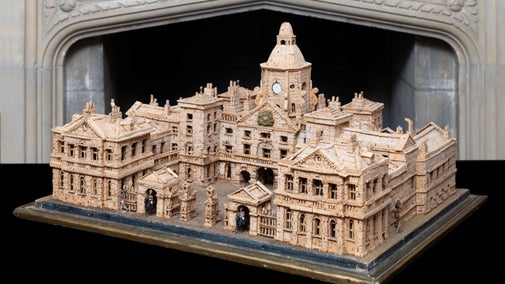
Sutton Hoo's collections
Explore the objects and works of art we care for at Sutton Hoo on the National Trust Collections website.

Over the winter of 2019/2020, photographs from the archive at Sutton Hoo were digitised for the first time. The images, captured by Mercie Lack and Barbara Wagstaff, were taken during the summer of 1939 and provide a remarkable insight into the people and processes behind the excavation of the Great Ship Burial.
The collection includes original colour prints, an incredible survival from the very earliest days of the use of colour reversal film, and original 35mm Agfa Isopan F negative film.
The prints, as far as research has shown, appear to be the earliest surviving original colour photographs of a major archaeological excavation. The collection consists of photograph albums, loose black and white images and negatives.

The digitisation process is just the latest part of the process in caring for the image archive. The Lack and Wagstaff photographs have been carefully catalogued over a two year period by volunteers and staff under expert guidance.
Any remedial conservation work required, such as repairing small tears, was also undertaken at the same time and each album was housed in a bespoke portfolio folder.

The photographers of the excavation were Mercie Lack and Barbara Wagstaff. Lack and Wagstaff, both teachers, were close friends and amateur photographers. They had a keen interest in archaeology and were on holiday in the area at the time.
Between 8 and 25 August 1939, they captured 400 images (including some very early colour images) and an 8mm cine film. Their original images were generously given to the National Trust by Mercie Lack’s great nephew, Andrew Lack.
The original photographs were in a very delicate state and they needed careful preservation to ensure their future. Colour photographs from this period need to be kept in a closely controlled environment to prevent them from deteriorating. A cool stable temperature and a low stable humidity are required to keep them in the best possible condition.
The albums consist of very fragile and thin paper and each time they are handled there is the risk of irreparable damage. By digitising the collection, the images can be easily accessed and shared without fear of damaging the originals.
- Mercie Lack, photographer
The design of the original album bindings meant that the pages could not be fully opened without causing further damage. To resolve this, the albums were unclipped, meaning each page could be individually photographed without damaging the original pages or albums.
Each album page had several high-resolution digital photographs taken using an overhead camera, under studio lighting. Firstly, an image was taken of the whole album page, including the many detailed annotations made by Lack and Wagstaff. This was followed by individual high-resolution photographs of the original images. In total over 4,000 images were taken during the digitisation process.
Documentation recorded alongside this process ensured that the original order and context of the images in the albums was retained. Each image captured was then inspected to make sure it is up to the required standard.

Explore the objects and works of art we care for at Sutton Hoo on the National Trust Collections website.
Find out what was discovered beneath the earth in a quiet corner of Sutton Hoo in Suffolk, and why the Anglo-Saxon find was so significant.

Delve into the world of Anglo-Saxons and discover the treasures unearthed and the story of this world-famous site.

Discover more about the people behind the archaeological investigations at Sutton Hoo.

Explore the atmospheric 7th-century Royal Burial Ground at Sutton Hoo and discover the history and mystery of what lay beneath the earth at this special place.

The art and heritage collections we care for rival the world’s greatest museums. Learn more about the collection of paintings, decorative art, costume, books, household and other objects at historic places.

See the breadth of our collection of works of art, furniture and more: we care for around a million objects at over 200 historic places, there’s a surprise discovery around every corner.

Discover the stories behind some of the greatest artworks and artefacts looked after by the National Trust, as told in a dedicated book, 125 Treasures from the Collections of the National Trust.
